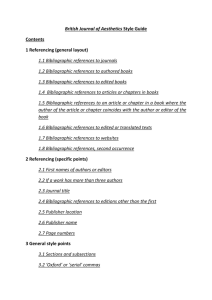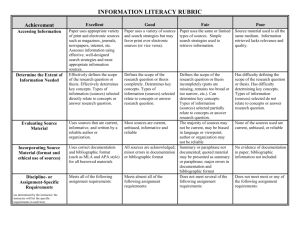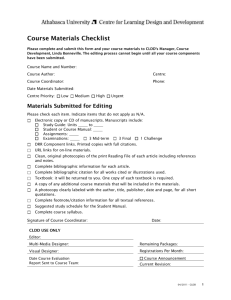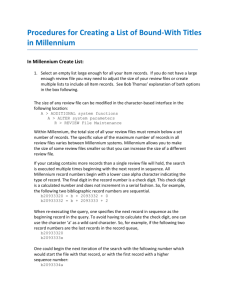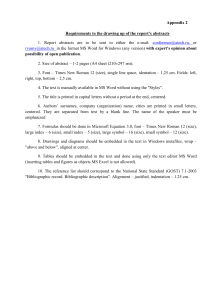British Journal of Aesthetics Style Guide
advertisement
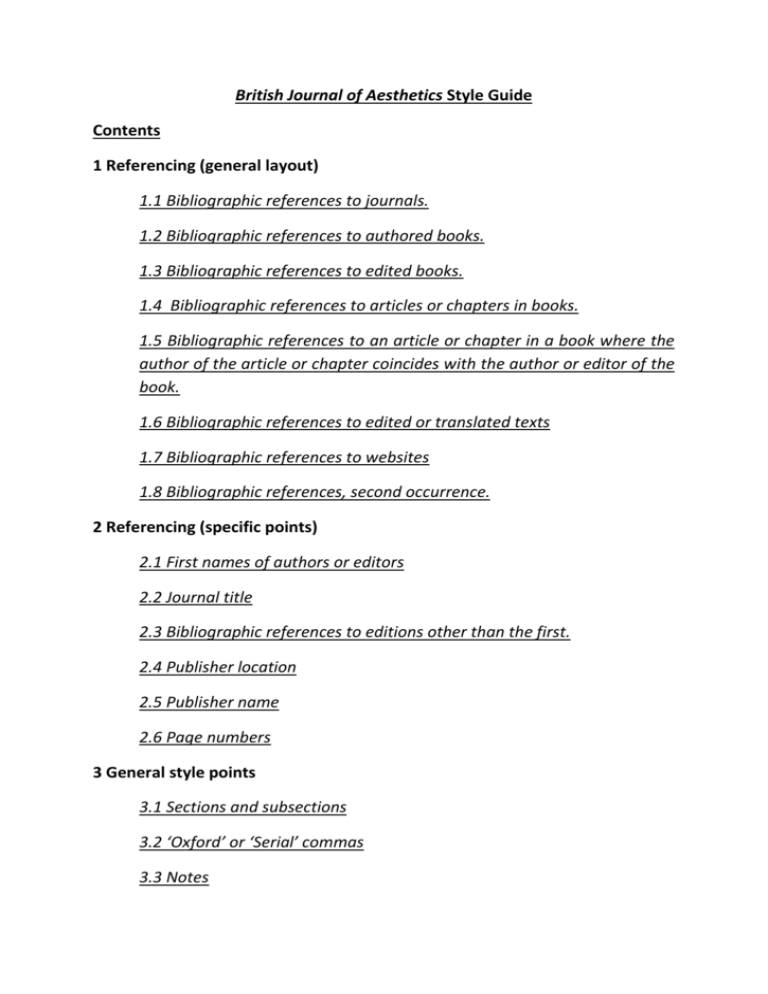
British Journal of Aesthetics Style Guide Contents 1 Referencing (general layout) 1.1 Bibliographic references to journals. 1.2 Bibliographic references to authored books. 1.3 Bibliographic references to edited books. 1.4 Bibliographic references to articles or chapters in books. 1.5 Bibliographic references to an article or chapter in a book where the author of the article or chapter coincides with the author or editor of the book. 1.6 Bibliographic references to edited or translated texts 1.7 Bibliographic references to websites 1.8 Bibliographic references, second occurrence. 2 Referencing (specific points) 2.1 First names of authors or editors 2.2 Journal title 2.3 Bibliographic references to editions other than the first. 2.4 Publisher location 2.5 Publisher name 2.6 Page numbers 3 General style points 3.1 Sections and subsections 3.2 ‘Oxford’ or ‘Serial’ commas 3.3 Notes 3.4 Spelling 4 Quotations 4.1 Capitalization and the use of square brackets 4.2 Quotation marks before or after a punctuation mark. **************************************************************** Style 1 Referencing (general layout) Please use footnotes rather than a bibliography. 1.1 Bibliographic references to journals. Author, ‘Title’, Journal Volume (Year), Pages, at Specific Page/s. Kathleen Stock, ‘Resisting Imaginative Resistance’, Philosophical Quarterly 55 (2005), 607–624. Jerrold Levinson, ‘What a Musical Work Is’, Journal of Philosophy 77 (1980), 5– 28, at 26. 1.2 Bibliographic references to authored books. Author, Title (City: Publisher, Year), Specific Page/s. Kendall Walton, Mimesis as Make-Believe (Cambridge, MA: Harvard University Press, 1990). Mary Mothersill, Beauty Restored (Oxford: OUP, 1984), 23–31. 1.3 Bibliographic references to edited books. Author (ed./eds), Title (City: Publisher, Year), Specific Page/s. Carolyn Korsmeyer (ed.), Aesthetics: The Big Questions (Oxford: Blackwell, 1998). Manuel García-Carpintero and Max Kölbel (eds), Relative Truth (Oxford: OUP, 2008), 119–122. 1.4 Bibliographic references to articles or chapters in books. Author, ‘Title’, in Editor (City: Publisher, Year), Pages, at Specific Page/s. Stacie Friend, ‘Imagining Fact and Fiction’, in Kathleen Stock and Katherine Thomson-Jones (eds), New Waves in Aesthetics (London: Palgrave Macmillan, 2008), 150–169. 1.5 Bibliographic references to an article or chapter in a book where the author of the article or chapter coincides with the author or editor of the book. Use the formula ‘in her’ or ‘in his’. Noël Carroll, ‘Interpretation, History and Narrative’, in his Beyond Aesthetics (Cambridge: Cambridge University Press, 2001), 133–156, at 135. 1.6 Bibliographic references to edited or translated texts Use ed. and trans. Ludwig Wittgenstein, On Certainty, ed. George Henrik von Wright and Gertrude Elizabeth Margaret Anscombe, trans. Gertrude Elizabeth Margaret Anscombe (Oxford: Blackwell, 1969). 1.7 Bibliographic references to websites Author, Title (Location, Date; Online Publication Date) <Web Address> Date Last Accessed William Strunk, The Elements of Style (Geneva, NY, 1918; published online July 1999) <http://www.bartleby.com/141> accessed 14 Dec 1999. 1.8 Bibliographic references, second occurrence. When the following reference is identical to the immediately preceding one, ‘Ibid.’ will be used. Do not italicize. When a reference is after the first time, but is not identical to the immediately preceding one, then only the surname of the author and the first part of the title will be written (where the ‘first part’ is the part of the title before the colon or other major punctuation mark, but not comma). Use the full first part, e.g. ‘The Purposiveness of Form’ rather than ‘Purposiveness of Form’. 27 Rachel Zuckert, ‘The Purposiveness of Form: A Reading of Kant’s Aesthetic Formalism’, Journal of the History of Philosophy 44 (2006), 599–622. 28 Ibid., 609–610. 29 Allen Carlson, Aesthetics and the Environment (New York: Routledge, 2000). 30 Patricia Matthews, ‘Scientific Knowledge and the Aesthetic Appreciation of Nature’, Journal of Aesthetics and Art Criticism 60 (2002), 37–48. 31 Zuckert, ‘The Purposiveness of Form’, 621. 2 Referencing (specific points) 2.1 First names of authors or editors As published in the cited article. 2.2 Journal title Full title, unless the journal is the British Journal of Aesthetics, in which case abbreviate to BJA. 2.3 Bibliographic references to editions other than the first. Use ‘edn’. Paul Guyer, Kant and the Claims of Taste, 2nd edn (Cambridge: Cambridge University Press, 1997). 2.4 Publisher location City only, except for disambiguation (e.g. London, Ontario). Always provide the two-letter state code for American cities, unless the city is one of the following: New York, Los Angeles, San Francisco, Chicago, Boston, Philadelphia 2.5 Publisher name Full name, unless the publisher is Oxford University Press, in which case abbreviate to OUP. 2.6 Page numbers Do not truncate page spans – provide page numbers in the format 238-239. Do not use p. or pp. Always provide page numbers rather than chapter numbers, unless the reference is to a classic text for which it is conventional to refer to book, chapter or section numbers, e.g. Locke’s Essay and Hume’s Treatise. Use ‘ch.’ or ‘chs’. 3 General style points 3.1 Sections and subsections All sections should be numbered, either with Roman numerals (if there is no title), or with Arabic numerals (if there is a title). All words will be capitalized in titles, except the first word, prepositions, articles (‘an’, ‘the’) and conventionally lower case elements such as the ‘sapiens’ in ‘Homo sapiens’. Subsections will be in italics, but not numbered. 3.2 ‘Oxford’ or ‘Serial’ commas Optional. 3.3 Notes Notes should be kept as short as possible and inessential material excluded. 3.4 Spelling Use Oxford UK spelling (-ize endings). 4 Quotations 4.1 Capitalization and the use of square brackets The beginning of a quotation will be in upper or lower case according to the usual rules of capitalization (with the exception of a quotation after a colon, see below). Square brackets will not be used at the beginning of a quotation irrespective of whether or not the original quotation was in upper or lower case. 4.2 Quotation marks before or after a punctuation mark. Single quotation marks will be written before the end punctuation mark, with the superscript for the footnote after the end punctuation mark. The forms of the facts, depictable by propositions, are determined by the logical forms of the simple and unalterable objects that make up the ‘substance of the world’.19 There will be the following exceptions: After a colon when a full sentence is quoted; and where the end punctuation is an exclamation or question mark or a full stop included in the quoted passage. A recurring comparison in Wittgenstein work is that between music and language. Its earliest instance is from 1915 when Wittgenstein writes that ‘musical themes are in a certain sense propositions.’14

